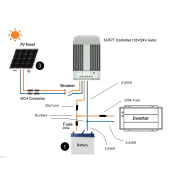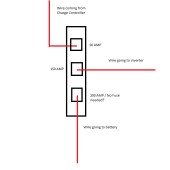Viewtiful_Jon
New Member
- Joined
- Oct 11, 2021
- Messages
- 13
Hello, I have a very small system I have not set up yet as I do not need it quite yet and want to make sure everything is protected first. I will list all the components in the order that they will be connected once the system is completed. I will be physically connecting the solar panel last.
400W Solar Panel ( 1 single panel )
1 meter MP4 cables (10AWG)
150v/40a Charge controller (Epever one with metal case)
8AWG Cables
12v 100ah Lithium Battery (will likely get a second when I know everything is running smoothly)
Cables that come with the inverter I think that they are 4AWG
1000w Inverter
I do not have the MP4 or the 8AWG cables yet they are just the ones I plan to purchase and am pretty sure are correct for the system.
Will a small system like this need to be protected by fuses and if so what type and where should I place them?
400W Solar Panel ( 1 single panel )
1 meter MP4 cables (10AWG)
150v/40a Charge controller (Epever one with metal case)
8AWG Cables
12v 100ah Lithium Battery (will likely get a second when I know everything is running smoothly)
Cables that come with the inverter I think that they are 4AWG
1000w Inverter
I do not have the MP4 or the 8AWG cables yet they are just the ones I plan to purchase and am pretty sure are correct for the system.
Will a small system like this need to be protected by fuses and if so what type and where should I place them?




